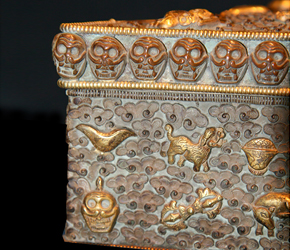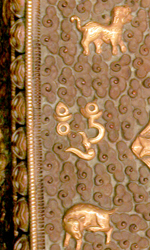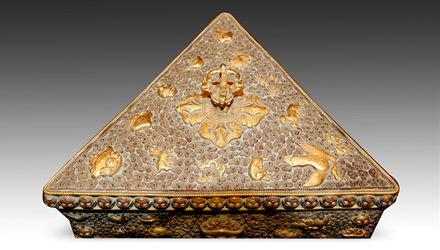Buddhist Triangular Storage Box
 |
|
This silver storage box was created to hold items related to various tantric rituals and ceremonies, primarily executed by Buddhist monks trained in various esoteric practices. There is no specific accounting for its triangular shape, so one can almost say this was an artistic device chosen by the craftsman for aesthetics and distinction. The motifs, however, reveal a deep understanding of various Buddhist subjects.
 |
|
The sculpture protruding from the lid of the box is a vadra, or vajra, and is meant to serve as a handle for the Box. Vajra is a Sanskrit word which means both thunderbolt and diamond. It represents a symbolic weapon, and in Tibetan and Nepalese Buddhism is associated with numerous deities, all of whom carry it as a reminder of “the power of impermanence.” In Tibetan, it is called a Dorje (Dor-jay). Dorjes are usually hand held, and make it possible for the devout to break the bonds of worldly attachment.
Other motifs on the box include ritual knives, animal figures, skulls and dorjes, explained above and shown again at left. The ritual knives are tools usually held by wrathful deities, symbolizing one’s ability to cut the bonds of worldly attachment. The skulls directly reference the Buddhist doctrine of impermanence. In the Nepalese, Tibetan, and Buddhist tradition death is seen as illusory. It is the result of consciousness combined with a personal and separate ego. The skulls also symbolize the illusory nature of death. Finally, the skulls symbolize the Citipati. According to Buddhist legend, the Citipati were two ascetic monks. Once they were lost in a deep meditation and did not notice that a thief had killed them and thrown them in the dust. When they awoke, they were skeletons and upon realizing their condition they became eternal enemies of the thief and all they stood for – dependence on the illusory, physical world, identification with the ego, and disrespect for the teachings and practice of Buddhist principles. They are guardians of the devout.
Also on the box is the symbol “om.” It represents a sound from which all of creation springs. It also represents the Tibetan mantra, “om mani padme hum,” one of the oldest and most important mantras in Tibetan Buddhism. Tibetan Buddhists believe that saying the mantra (prayer) out loud or silently to oneself invokes the powerful benevolent attention and blessing of Chenrezig, the Buddhist deity who is the embodiment of compassion. Viewing the written form of the mantra with all its letters or in short form as it appears on the box is said to have the same effect as repeating the mantra out loud.
Download this Article: Buddhist Triangular Storage Box.pdf
